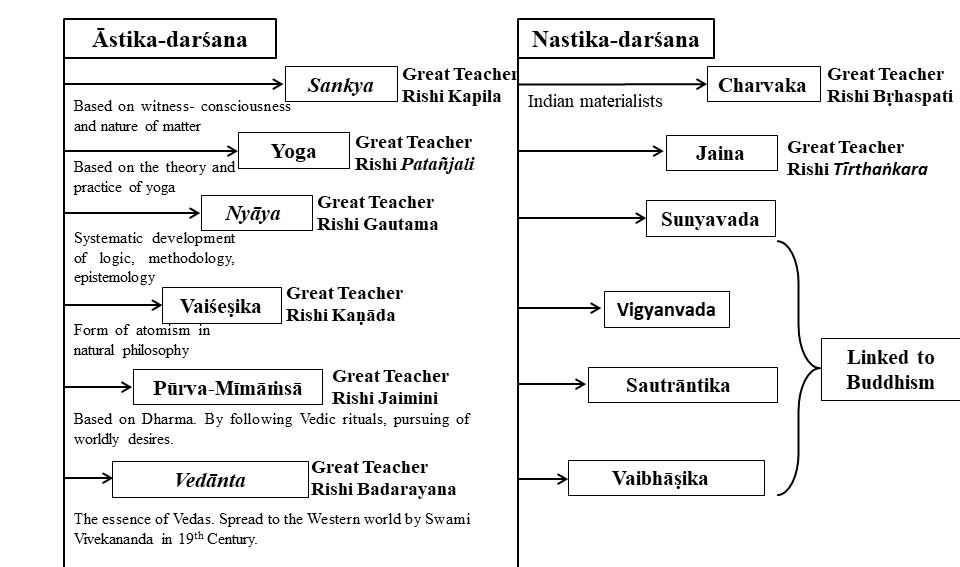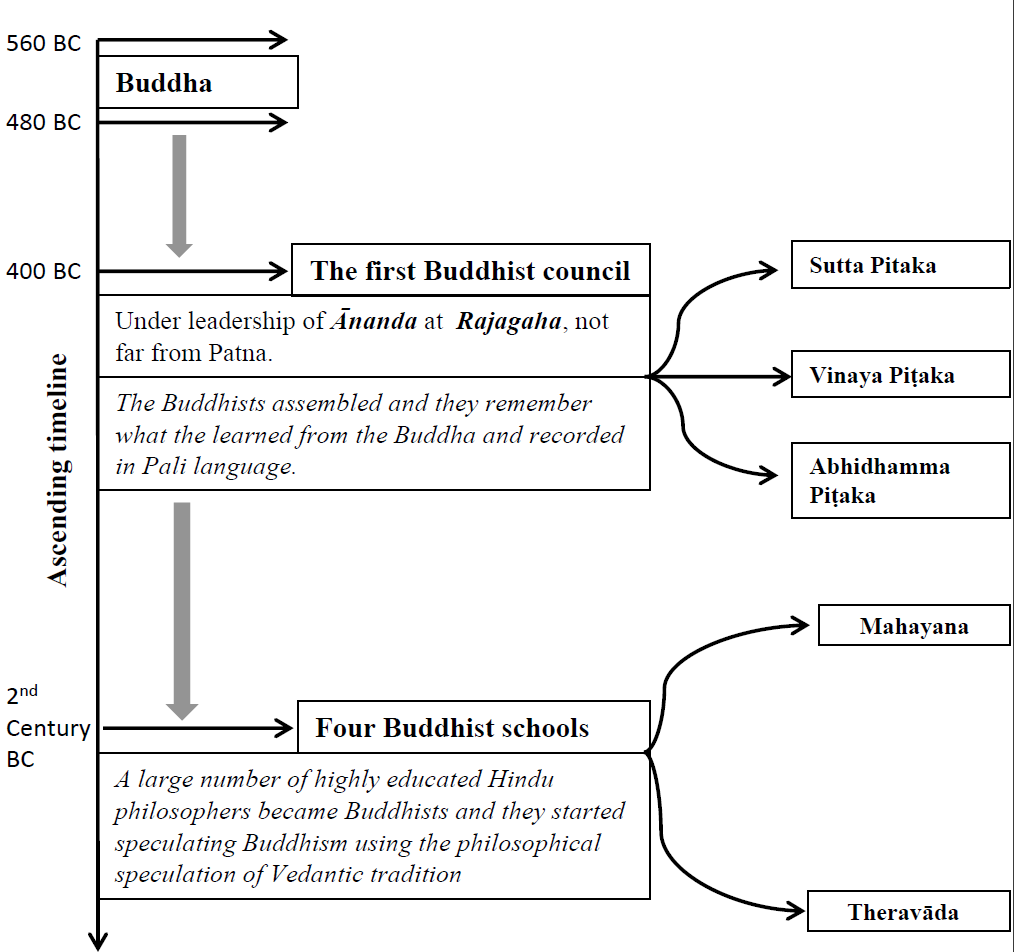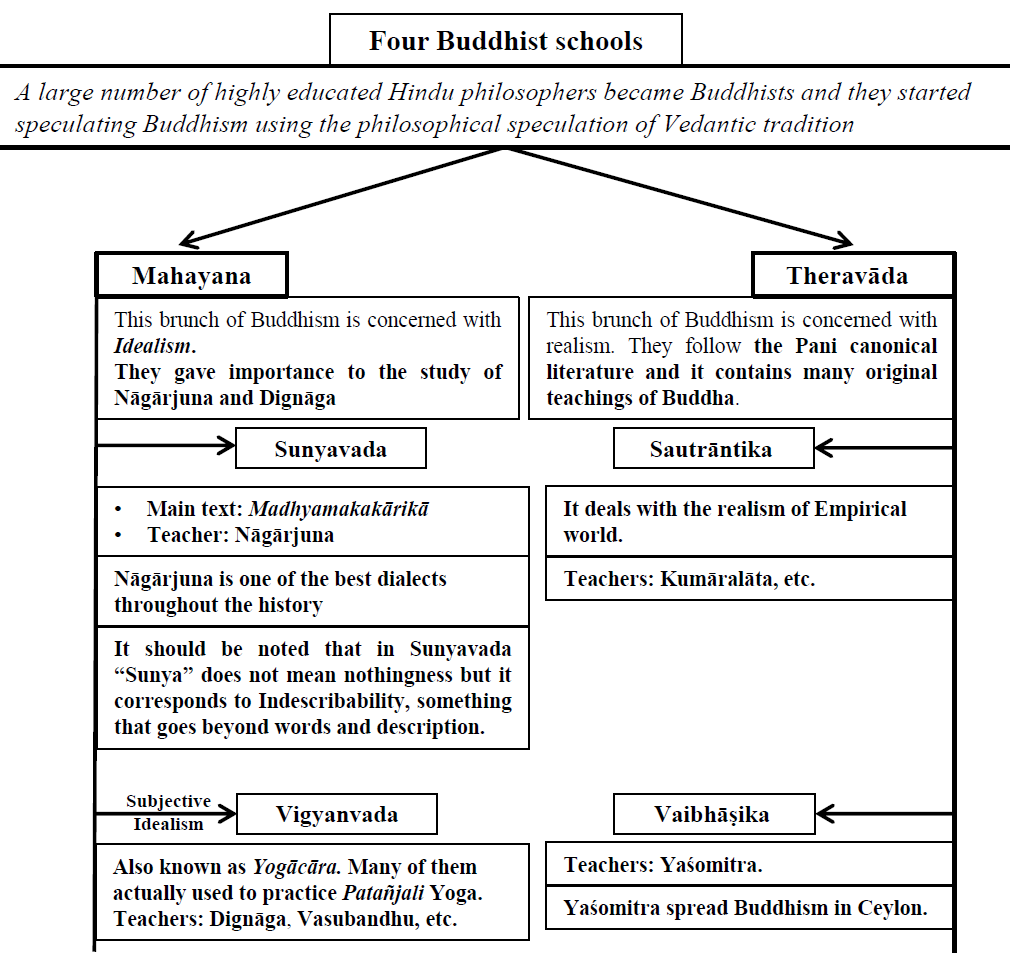Akash Kundu
I.. a universe of atoms an atom in the universe.
Indian Philosophy
by Akash Kundu
The list of contents:
- A small introduction to Indian Philosophy
- "Now I Am Become Death, the Destroyer of Worlds"
- Understandably Quite a Curious Day for शौनक (Shaunaka)
A small introduction to Indian Philosophy
In the following I am presenting my understanding based elaboration and illustration of The Foundational text in Indian Philosophy. All the images are unique and proper references are mentioned in the text. My special thanks to Aritra Sarkar, Tamal Acharya and Chandika Pegu for going though the article and valuable comments.
Why it is important to study?
In Indian tradition there is word called “Parampara” that literally means a continuous flow, just like a river. So if you get into the river you temporarily become the part of the flow.
Indian spiritual and philosophical traditions are just like a continuous a continuous flow. Hence it represents a succession of the teacher and the student where the student becomes an integral part of the teacher’s lineage.
A Piece of Dry Leaf Floating in the Air
While discussing philosophy an ideal teacher should give justice to the subject the teacher is dealing with, which means whenever a statement is made in the process of learning the teacher must give scriptural/textural link from where it is coming.
This is quite important in the modern era of Internet. The main reason behind this is if someone teaches a system of philosophy or spirituality without giving any connections with the teachers or ancient masters then it could be anything from a crazy non-authentic idea to a wild spiritual fantasy of his/her mind that can spread around the world to bind a group of people into a belief or understanding that does not have a scriptural testimony. As an example, Mindfulness, whose essence is being in a state of absolute and complete awareness and detachment is a very important and popular in modern times, which is based on a Buddhist canonical literature called Mahā Satipaṭṭhāna Sutta (in Pali) which translates into “the establishing (upaṭṭhāna) of mindfulness (sati)” or Mahā Smṛtyupasthāna (in Sanskrit). There are two verses Mahā Satipaṭṭhāna Sutta represents the bigger full version of the verse whereas Satipaṭṭhāna Sutta is the smaller one.
Now suppose while teaching this you forget Buddha or you refuse to accept any connection with the real great Buddha then the whole topic of “Mindfulness” will be like “A Piece of Dry Leaf Floating in the Air” one day it could be forgotten.
And if you always refer the topic of Mindfulness with the background of a great spiritual teacher, the World once produced, who himself was an embodiment of Mindfulness then the question of getting deviated from the main essence of the practice never arises due to its unshakable root.
Twelve Distinct Philosophical Systems
Any book on Indian Philosophy refers to twelve distinct systems of philosophy in Indian tradition. In fact there are more systems but the mentioned twelve are one of the most important ones. Behind every idea, every system of philosophy there is a great sage, a great meditative mind. They not only had a highly philosophical and spiritual mind but they used to live in a world of higher philosophy. Let us jump into Indian philosophical systems which are fundamentally split into two kinds of outlooks based on the fundamental source of spiritual revelation“Āstika-darśana” and “Nastika-darśana”. See the Figure below.

“Āstika” and “Nastika” was first introduced in Aṣṭādhyāyī, dated to around 500 BCE, is a Grammar that describes an Indo-Aryan form of Sanskrit. It is Authored by a Sanskrit Philologist and scholar Pāṇini. In the Aṣṭādhyāyī on 4th Chapter of verse 4.4.60 Pāṇini mentions:
One of the fundamental differences in Āstika-darśana” and “Nastika-darśana” is that:
Nastika does not believe in continued existence of life after death but to live a good life in this world. Whereas Āstika does not only believe in continued existence but they imply that the human life is not for enjoyment but meant for a higher purpose and in Vedanta this higher purpose is to realize your own spiritual identity.
There are a total of 7 schools of Vedanta with their own interpretation on spiritual reality based on their own interpretation of Brahma Sūtras. We will elaborate on them pretty soon
Both the “Āstika” and “Nastika” are divided into six schools of Philosophy. As shown in the following illustration:

The Origin of the Four Schools of Buddhism
Before talking elaborately about the four schools of Buddhism that emerged in India long after Buddha’s passing, we must understand that The Buddha was not concerned about the metaphysics or philosophy, his system of teaching was purely based on a desire. A desire to see people living a good life in this world. His teachings were not concerned on life after death.
We can divide Buddhism into two stages as (1) Early (2) Later developements in Buddhism. Which is illustrated in following:

Among the Four Buddhist Schools Sautrāntika and Vaibhāṣika are part of Theravāda whereas Sunyavada and Vigyanvada (or Yogachara ) are part of Mahayana as depicted in the following:

The four schools are classified according to epistemology i.e. the theory of knowledge. The knowledge related to a question:
Sautrāntika: According to this school, we are directly perceiving the universe. There are things in the universe and we are perceiving it with our senses. So there are the "experiencer" and what we are experiencing is outside the "experiencer".
Vaibhāṣika: According to this school, what you are seeing now, is a representation of what existis outside, in your mind. So there is "something" outside, the information about the "something" is collected by your saenses, and then the information is recreated in your mind hence what you are preceiving is a recreation of the reality. This is what modern 21st science would agree upon and termed as Representative reality, which was established in India 20 century ago in a more sophisticated manner.
Vigyanvada: According to this school, they consideer the reality is only mind. The main question they explore is "How do you know there is something exists to preceive at all?" If there is something outside then yopu have noi access to it so in mind the world is formed. In simple words there is no outside world only your mind. Through this practice you cut off the external world, that is why it is also called Yogācāra.
Sunyavada: According to this school, there is no mind, no external world but only Sunyata. It should be noted that "Sunyata" should not be taken as nothingness. The studies of this school is completely based on the Mūlamadhyamakakārikā by Nāgārjuna. He was concerned about a question:
One can formulate four possible responses which is called "Catuṣkoṭi". And they are as follows:
(1) Positive: It exists.
(2) Negative: It does not exists.
(3) Conjunction: It exists and it does not exists.
(4) Denial of Conjunction: It neither exists and it nor does not exists.
(Stay tuned…)
REFERENCES
[1] The Foundational Texts of Indian Philosophy (Overview) by Swami Tattwamayananda
[2] Mandukya Upanishad (Chapter 3 Karika 29-30) by Swami Sarvapriyananda
[4] Mindfulness
"Now I Am Become Death, the Destroyer of Worlds"
The title of this section was quoted by the great physicist J. Robert Oppenheimer when he was experiencing the detonation of the first atomic weapon in the year 1945. Some of us might be able to recreate the scenario using our imaginations, where a growing mountain-sized mushroom cloud of fire suddenly appears in front of your eyes followed by a burst of wind as an aftermath of the explosion. It is probably like seeing thousands of sunrises together in front of you and you as an observer just stare in astonishment. But here we will not explore the psychological aspect of Oppenheimer but we stress understanding the source of this beautifully horrifying quote and its original meaning.
There are a total of 18 chapters and a whopping 200,000 verses in the epic The Mahabharata. Bhagavad Gita is a Hindu sculpture that contains 700 verses from The Mahabharata. The Bhagvad Gita captures the conversation between the Lord Krishna and Pandavas prince Arjuna in the battle field of Kurukshetra, facing an opposing army that contains his close relatives. Arjuna is completely torn. Amid this Lord Krishna teaches him about a higher philosophy that will enable him to carry out his duties as a warrior irrespective of his concerns.
During the 10th chapter, Arjuna asks Lord Krishna to show his true form. In the 11th chapter Lord Krishna reveals his true form which is famously known as Viśhwarūp Darśhan but before that, he gave Arjuna a glimpse of his true form in the 10th chapter and is captured by Sanjaya through the 34th verse:
In English pronunciation:
Let us understand the meaning of the “mrityuh sarva-harash chaham udbhavash cha bhavishyatam”, word by word. In Sanskrit
(1) mrityuh means Death
(2) sarva-haraḥ means All-destroying
(3) chaham means And I
(4) udbhavash means The origin
(5) cha means And
(6) bhavishyatam means Those things that are yet to be
Which together says
“I am the all-destroying death, and I am the origin of those things that are yet to be…”
In Sanskrit mrityuh means death but before considering death as the destruction of the physical body let us analyse it a bit more deeply. As we can see in the last half of the phrase Lord Krishna says “I am the origin of those things that are yet to be”, which indicates the emphasis on the time because the physical death of the body of a creature or an entity appears in time. This makes time a great measuring scale of existence, it devours everything and everyone eventually. Interestingly the Sanskrit word haraḥ in sarva-haraḥ can also be interpreted as devouring. This leads us to do a simple exercise which you can do right now. Close your eyes and construct a mental picture of time (maybe as a physical entity) opening up its huge mouth and eventually devouring the whole existence, and behind time, Lord Krishna, with his sublime smile and spreading his infinitely extended palm which devours the existence consuming time itself. This leads us to grasp the actual meaning of the phrase
"I am the all-destroying time, and I am the origin of those things that are yet to be..."
This has some interesting implications on the concept of the almighty God, whom we interpret as the creator of the world, the universe, and the existence itself. Because when we say the words like "world", "universe" or even "existence" we subconsciously (and alarmingly) confine God within the limitations of space and time which philosophically is a great degradation to any sublime concept. But through the 34th verse of the 10th chapter Lord Krishna shows us that God is all-pervading which is described in the amazing 16th verse of the 11th chapter.
REFERENCES
[1] The Cycle of Existence is Within the Divine by Swami Tattwamayananda
[2] Manifesting the Divinity Within by Swami Tattwamayananda
[3] The amazing 16th verse of 11th chapter
Understandably Quite a Curious Day for शौनक (Shaunaka)
Often, while reading a research paper, I have noticed that the paper’s authors refer to methods/techniques of research work from the past. To understand the current research, I jump from one reference to another to get a proper grasp of the paper. Which in a few instances broke the limit of my patients. To find out a way around I stress finding a review article or a research paper that might contain an overview of the methods required for understanding. Sometimes, I also consult with my supervisor to get a recommendation for such an article. In both scenarios, ideally, my main motive is to:
After carefully examining my mindset just before the thought of finding a singular source arises, I came to the bold conclusion that humans are usually either driven by fatigue, laziness or, to save their time, feel motivated to look for a unified source of knowledge. Another quite rare scenario that can motivate a human being is that the person might be too disturbed by the nonduality of this reality. For a simple example:
If we look outside on a sunny day and observe “the leaves of a tree are shining light yellow as the sunlight falling on the surface of the leaves,” in that tiny observation if someone wants to gather all the information about the scene, the person explicitly needs to know (1) the properties of the sunlight, including the characteristics of the photons and its angle of inclination on the surface, (2) the characteristics of the surface of the leaf, including its botanical anatomy and finally (3) how the quanta of light interacts with the physical and geometrical properties of the leaf. A careful consideration will help us understand that in the above scenario, we did not even consider the aerodynamic influences on the leaves.
This is indeed demotivating and not at all efficient! So what is the solution? Will our mind always be deprived of the knowledge of the reality?
Not really.
One way to optimize the knowledge-gathering process is to realize a source which contains all the knowledge about reality. Indirectly, it is the ultimate cause, the cause of everything. By staying aware of the appearance and the diverse nature of reality, it is encouraged to backtrack to the source/cause itself. As a cause instigates an effect or a variety of effects, by knowing the cause, you will learn everything.
But wait! This sounds like the big bang! Isn’t it?
Unfortunately, you are partially correct, as the Big Bang is responsible for the emergence of baryonic matter, radiation and possibly the dark sector of the universe. The term “reality” I mentioned also contains the scenario before the Big Bang where the universe is not matter-filled. Hence, the “reality” I am referring to is:
Particle (anti-particle) + All the non-particle.
The discomfort of this diversity of the reality or maybe due to curiosity or by sheer laziness or possibly to save his precious time शौनक (Shaunaka) in Mundaka Upanishad have recourse to his master अङ्गिरा (Sage Angiras) to ask the following question:
In English pronunciation:
A step-wise translation leads us to:
(1) bhagavo (भगवो) means Lord,
(2) vijñāte (विज्ञाते) means To know something,
(3) kasmin nu (कस्मिन्नु) vijñāte (विज्ञाते) together means by knowing what,
(4) sarvamidaṁ or sarvam idam (सर्वमिदं) means all that is i.e. everything,
(5) vijñātaṁ (विज्ञातं) bhavatīti (भवतीति) means become known.
Great Philosopher Max Müller while studying Sanskrit translated Upanishads into English, he interpreted the question by Shaunaka as:
“Sir, what is that through which, if it is known, everything else becomes known?”
In this article, I am not interested in the philosophical aspect of the question but in understanding Shaunaka’s mindset just before the vital question appeared in his mind. Shaunaka was heavily indulged in Vedic rituals, and to perform these rituals, one required a lot of wealth, so he was rich. A rich man must have a very condensed career, and he is supposed to be usually busy. Before approaching Angiras, he had this suppressed desire to know everything around him. However, realizing that the world is filled with discrete knowledge and has uncountable things to gather, he felt motivated to look for a unified singular source of knowledge. This will not only help him to focus on a particular source/cause of everything and not get distracted by the appearance of the effect, but it will also save him precious time as a businessman. The main difference between me and Shaunaka, which makes him a great student, is that He had this intense desire to know the cause of everything, the source of this singular knowledge source.
REFERENCES
[1] Mundaka Upanishad, Mantras 1.1.8 - 9 by Swami Sarvapriyananda
